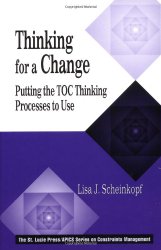Sat Aug 29 17:49:45 PDT 2015
Thinking for a Change by Lisa J. Scheinkopf
 |
Solving problems through diagrams is appealing and Lisa J. Scheinkopf's Thinking for a Change (not to be confused with Maxwell's Thinking for a Change), based on Eliyahu M. Goldratt's 'Thinking Processes', sets out a variety of diagramming methods focused on problem solving and creating change. The book is good but strangely organized. An abstract Part 1 explains the terms used in the Thinking Process diagrams and the general ideas that underlie the processes. A disjointed Part 2 illustrates the thinking processes in an order of presentation that may confuse the reader. Here the Transition Tree - that seeks plan out the activities needed to effect a change is presented first. This is followed by the Future Reality Tree, used to set objectives, and then the Current Reality Tree, used to identify the changes that need to be made. The reader could make the case that these chapters are in reverse order - and they are followed by a discussion of the Evaporating Cloud - which is the best known and most accessible Thinking Process, and then an overview of all of the Thinking processes applied in force, which emphasizes an entirely different ordering. Why Lisa elected to present her material in this order is not clear - my theory is that she is attempting to evangelize the less well known Thinking Processes - and therefore introduces them early in order to give them exposure. Aside from this - I was at a slight loss over the structure and intention of the book. The book has other failings: it is expensive at sixty dollars and its diagrams are often sprawling. The diagrams of the overall processes, for example, are grown in fractal fashion before the reader over several pages, each successive page shrinking a former part of the diagram and adding a new section. This diagram growing is not made clear to the reader - who is left to deduce what is happening to the diagram by flicking back and forth between the pages. It would have been better to show the entire diagram and then described the various parts.
Despite the failings in overall organization and the diagrams - the book is valuable and I recommend it to those interested in studying Goldratt's Thinking Processes in detail. The Evaporating Cloud diagram commonly provides insights when I use it to analyze problems and concerns and if you have not looked at it before - I would suggest that you take a look at this relatively simple construction - as it will certainly enable you to understand and resolve many conflicts - and at least develop additional perspectives that may be helpful to you. Several web site contain examples of Evaporating Clouds (see, for example, http://en.wikipedia.org/wiki/Evaporating_cloud). Thinking for a Change takes the analysis of Thinking Processes beyond what I have encountered on the web and is intended for the expert Thinking Processes person, I believe. I intend to apply myself to the material - but I should have liked a book that was easier to digest - and was perhaps shorter. Perhaps Lisa will create a second version which is simpler and more accessible than the first.
Here is an interesting site which provides additional information on the thinking processes and methods: http://www.dbrmfg.co.nz - it is well worth a visit.